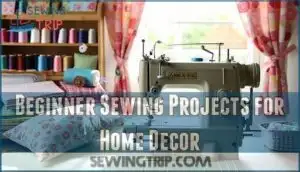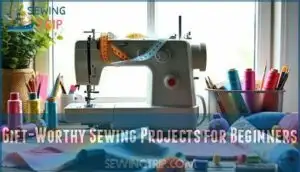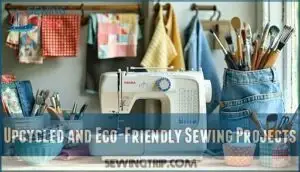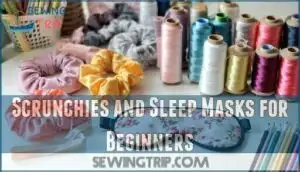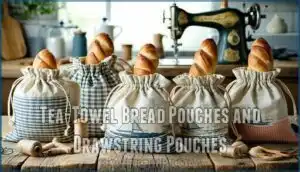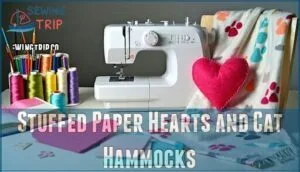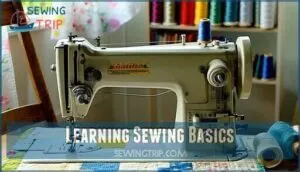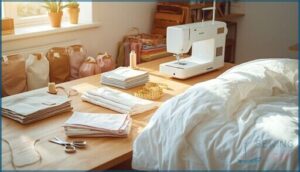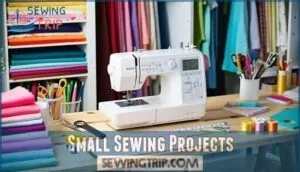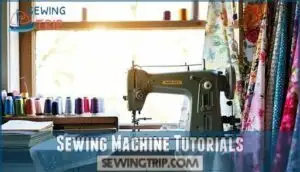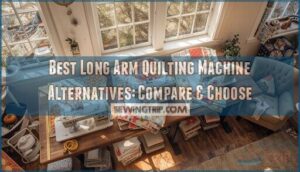This site is supported by our readers. We may earn a commission, at no cost to you, if you purchase through links.
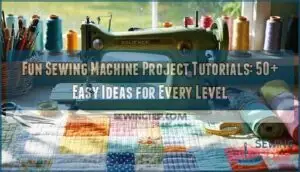
Start with simple projects like fabric coasters, scrunchies, and reusable snack bags that build your confidence while creating practical pieces.
These tutorials guide you through essential techniques like straight stitching and hemming, making each project a stepping stone to more complex creations.
Whether you’re crafting personalized gifts, upcycling old materials, or adding handmade touches to your space, these projects prove that machine sewing doesn’t have to be intimidating.
The secret lies in choosing the right starter projects that match your current skill level, allowing you to create practical pieces and personalized gifts with ease.
Table Of Contents
Key Takeaways
- You’ll build confidence and essential skills by starting with simple projects like scrunchies, fabric coasters, and drawstring pouches that use basic straight stitches and don’t require complex patterns.
- You can create practical home decor items such as canvas log bags, rolled hem napkins, and custom duvet covers that transform your living space while teaching you fundamental sewing techniques.
- You’ll reduce waste and save money by making eco-friendly projects like reusable snack bags, cloth napkins, and zero-waste sponges from fabric scraps and old materials.
- You can master your sewing machine by following YouTube tutorials from channels like Brother, Made to Sew, and Evelyn Wood’s Vintage Sewing School that provide step-by-step guidance for beginners.
Easy Sewing Projects
You’ll find that easy sewing projects help you build confidence while creating useful items for your home and loved ones.
These beginner-friendly tutorials teach essential skills through simple patterns that won’t overwhelm your schedule or budget.
Beginner Sewing Projects for Home Decor
Transform your living space with beginner sewing projects for home decor that’ll make your house feel like home.
Turn your house into a home with simple sewing projects that reflect your personal style.
These easy sewing tutorials help you create custom pieces without breaking the bank or your patience.
You can even start by making some eco-friendly projects to reduce waste.
- Simple Cushions – Add comfort and color to any room with basic pillow covers
- Wall Art – Create fabric bunting or framed textile pieces for personalized touches
- Table Runners – Dress up dining areas with custom fabric runners
- Easy Curtains – Frame windows with simple, no-pattern-required treatments
Gift-Worthy Sewing Projects for Beginners
Your home decor skills set the stage for creating memorable handmade gift ideas.
Stuffed paper hearts make perfect personalized gifts for holidays and baby showers. Tea-towel bread pouches paired with homemade treats offer budget-friendly gifts that show thoughtfulness.
Waterproof book covers and felt hot-water bottle cozies provide quick gifts requiring basic sewing skill level yet delivering impressive results.
Consider browsing beginner sewing kits for suitable project materials to create personalized gifts.
Upcycled and Eco-Friendly Sewing Projects
Giving gifts feels great, but creating something meaningful from what you already have feels even better.
Transform forgotten treasures into something beautiful – your hands, your heart, your home.
Upcycling transforms forgotten items into treasures while reducing textile waste. You’ll love these sustainable fabric choices that help the planet.
Here are winning zero waste sewing projects:
- Reusable cloth napkins from old fabric scraps
- Fabric bowl covers replacing plastic wrap entirely
- Quilt block totes covering promotional bag logos
Consider making reusable kitchen sponges from cotton fabric to reduce waste.
Best Sewing Projects
You’ll find the best sewing projects combine quick results with practical use in your daily life.
These top picks include scrunchies for your hair, sleep masks for better rest, and drawstring pouches that organize your belongings perfectly.
Scrunchies and Sleep Masks for Beginners
Scrunchies make perfect starter sewing projects since you’ll master fabric choices and elastic types quickly.
Cotton works best for beginners, while silk adds luxury.
Sleep masks require layering fabrics for comfort design—soft cotton inside, decorative fabric outside. Add bias binding around edges for a polished finish.
These beginner sewing tutorials teach essential skills through fun, wearable accessories, helping you master elastic types and understand the importance of polished finish.
Tea-Towel Bread Pouches and Drawstring Pouches
Tea-towel bread pouches bring warmth to your kitchen while showcasing your sewing machine skills.
These sewing projects use discount kitchen towels stitched together, leaving the top open.
Fabric selection affects durability, while closure methods vary from simple ties to drawstring pouches.
Size variations accommodate different loaves.
Sewing tutorials for beginners highlight customization options and gifting ideas for homemade treats.
For summer projects, consider making a beach tote bag with coastal fabrics, which can add a personal touch.
Stuffed Paper Hearts and Cat Hammocks
Create stuffed paper hearts by sandwiching tissue between parchment sheets and machine-stitching around traced templates.
These sewing projects make perfect gifts for any occasion.
Cat hammocks require pet-safe materials and careful fabric choices – cotton works well for beginners.
Both projects help develop your beginner sewing skills while creating meaningful items.
Follow sewing tutorials for beginners to master these techniques, and remember to use pet-safe materials.
Learning Sewing Basics
You’ll need to understand your sewing machine’s basic parts and functions before starting any project.
Practice straight stitches on scrap fabric first, then work through simple techniques like turning corners and guiding fabric smoothly under the presser foot to master the basics.
Familiarizing Yourself With Sewing Machine Parts
Before diving into your first project, spend time exploring your sewing machine’s essential components.
Read the manual to understand machine functions, from threading guide pathways to bobbin loading mechanisms.
Locate stitch selection dials and tension controls.
Familiarize yourself with basic sewing machine accessories and maintenance tips.
This foundation prevents frustration and builds confidence for successful sewing techniques ahead.
Practicing Straight Stitches and Basic Sewing Techniques
Mastering straight stitches transforms your sewing machine from intimidating gadget to trusted companion.
Start with these fundamental techniques that’ll build your confidence:
- Seam Allowance Practice – Maintain consistent ⅝-inch margins using your presser foot as a guide
- Fabric Guiding – Let the machine feed fabric naturally without pushing or pulling
- Tension Control – Adjust stitch length and thread tension for perfectly balanced, consistent lines on any material
These techniques are essential for improving your sewing skills and will help you become more comfortable with your sewing machine.
Home Decor Sewing
You can transform your living space with simple home decor sewing projects that add personal style to every room.
These projects include canvas log bags for storage, rolled hem napkins for dining, and custom duvet covers that refresh your bedroom without breaking the budget, which can be considered a budget-friendly option.
Canvas Log Bags and Floor Runners
Creating sturdy home accessories transforms your living space with practical charm.
These canvas log bag and floor runner sewing projects showcase excellent canvas durability while teaching essential stitching techniques.
Your sewing machine handles heavy-duty materials beautifully with proper needle selection.
A great option is to find a durable carry solution for firewood.
| Project Feature | Canvas Log Bag | Floor Runner |
|---|---|---|
| Runner Materials | Single canvas piece | Four carpets (22"×33") |
| Handle Attachment | Leather handles sewn | Whipstitch binding |
| Stitching Techniques | Folded hem construction | Edge-to-edge joining |
| Project Customization | Size adjustments | Pattern variations |
| Difficulty Level | Beginner-friendly | Intermediate skills |
Both sewing tutorials emphasize precise measurements and reinforced seams for lasting results.
Rolled Hem Napkins and Duvet Covers
For rolled hem napkins, your fabric selection matters—linen works beautifully at 48x48cm napkin sizes.
Master hemming techniques using a serger’s 3-thread setting for crisp edges.
Duvet covers require simpler sewing machine skills—just stitch two sheets together, and skip complicated duvet fasteners and use ribbon ties instead.
These sewing projects offer endless project customization through fabric choices and decorative threads in your sewing tutorials, and you can find various rolled hem options online, allowing for endless customization.
Embroidered Stockings and Personalized Decor
Now you can personalize your space with embroidered stockings that showcase your favorite colors and handwriting.
These custom decor projects make perfect holiday gift ideas and Christmas décor.
Choose cotton or felt fabric – fabric choice matters for durability.
Practice basic embroidery stitch types like backstitch and French knots.
These sewing project tutorials create meaningful personalized gifts that’ll become treasured keepsakes for years.
Small Sewing Projects
Small sewing projects are perfect when you want to practice your skills without committing to large, time-consuming creations.
You’ll master basic techniques while making useful items like fabric coasters, tote bags, and eco-friendly household essentials that take just a few hours to complete, allowing you to create useful items.
Fabric Coasters and Garlands for Beginners
Ready to tackle your first straight-stitch projects? Fabric coasters make perfect stitch practice for beginners using quilting cotton or flannel.
These quick crafts let you experiment with beginner fabrics while creating something useful. Fabric garland offers excellent project customization opportunities – mix patterns and colors to match your style.
Both easy sewing projects build confidence through simple, repeatable techniques that deliver satisfying results. They help you develop skills and experiment with beginner fabrics while making useful items.
Tote Bags and Reusable Snack Bags
Tote bag styles range from simple market carriers to sophisticated designs with multiple pockets.
These sewing projects teach essential skills while creating practical accessories.
Reusable snack bags offer excellent fabric waste reduction and superior bag durability comparison to disposable options.
- Farmers Market Tote: Features oversized pockets and reinforced handles for heavy groceries
- Water-Resistant Snack Bag: Includes velcro closure and washable liner for mess-free storage
- Drawstring Travel Pouch: Perfect for organizing accessories with leftover fabric scraps
Zero-Waste Sponges and DIY Dog Beds
Transform fabric scraps into eco-friendly cleaning tools with zero-waste sponges using cotton fabric and coarse mesh.
Stitch around rectangles at 1/4 inch, leaving gaps for turning.
For DIY dog beds, cut 36 five-inch squares from old denim for upcycling denim into durable pet furniture.
These reusable sewing projects reduce waste while creating practical household items. Consider using organic cotton options for enhanced sustainability and making practical household items.
Sewing Machine Tutorials
You’ll find the best sewing machine tutorials on YouTube channels like Brother, Made to Sew, and Evelyn Wood’s Vintage Sewing School.
These channels teach you step-by-step techniques that make learning your machine simple and clear.
Brother YouTube Channel and Made to Sew
When exploring sewing education online, you’ll discover two standout resources that make learning feel less intimidating.
Brother’s YouTube channel offers thorough sewing tutorials covering basic to advanced sewing machine projects, while Made to Sew provides structured beginner sewing tutorials with excellent community engagement.
Here’s what sets these channels apart:
- Tutorial Styles – Brother focuses on technical machine operations, Made to Sew emphasizes project-based learning
- Project Difficulty – Both offer easy sewing tutorials with clear skill development progression
- Channel Comparison – Brother provides equipment-specific guidance, Made to Sew offers broader technique instruction
- Community Engagement – Made to Sew fosters interactive learning environments for skill development
Evelyn Wood and Vintage Sewing School
Evelyn Wood’s Vintage Sewing School brings decades of Woods Expertise to modern sewers through thorough sewing education.
Her School Curriculum focuses on timeless Vintage Techniques that create lasting sewing machine projects.
The Online Community connects beginner sewing enthusiasts worldwide, sharing detailed sewing tutorials with Project Focus on traditional methods that build confidence and skill.
Regular maintenance can prevent common causes of malfunctions.
| Course Feature | Benefits |
|---|---|
| Vintage Techniques | Master traditional methods |
| Expert Instruction | Learn from Woods Expertise |
| Community Support | Connect with fellow sewers |
| Project-Based Learning | Build skills through practice |
Easy Sewing for Beginners and The Essentials Club
Easy Sewing for Beginners channels provide step-by-step guidance that makes learning feel less overwhelming.
The Essentials Club focuses on ethical sourcing and clear DIY steps, helping you build confidence with simple sewing patterns.
These beginner channels create a supportive sewing community where project inspiration flows freely.
You’ll find easy sewing tutorials designed specifically for sewing for beginners like yourself.
Frequently Asked Questions (FAQs)
What are easy sewing projects?
Looking to start your sewing journey? You’ll love making scrunchies, drawstring pouches, and fabric coasters.
These beginner-friendly projects use straight stitches and basic techniques, letting you practice while creating useful items for home.
What is the best sewing project for beginners?
Start with scrunchies using cotton fabric – they’re forgiving and teach basic machine skills.
You’ll practice straight stitches and turning corners without complex patterns.
Plus, you’ll have something cute to wear while mastering your new hobby.
How do I learn to sew for beginners?
Read your sewing machine manual thoroughly first.
Practice straight stitches on scrap fabric before starting projects.
Begin with simple items like tote bags or fabric coasters. Take your time, embrace mistakes as learning opportunities, and enjoy the process.
What are the best home decor sewing projects for beginners?
Canvas log bags, rolled hem napkins, and duvet covers make perfect starter projects.
You’ll master straight seams while creating useful items.
Floor runners from carpet squares teach you whipstitching.
Each project builds confidence for bigger challenges ahead, helping you to master straight seams and whipstitching.
Are there free downloadable sewing projects?
Yes, you’ll find plenty of free downloadable sewing projects online.
Many websites offer PDF patterns for beginners, including tote bags, coasters, and home decor items.
Just print at 100% scaling for accurate sizing.
What are some good ideas for small sewing projects?
You can create scrunchies, drawstring pouches, and sleep masks using fabric scraps.
Try tea-towel bread bags, tote bags with pockets, or fabric coasters.
These quick projects help you practice straight stitches while making useful items.
What thread weight works best for different fabrics?
All-purpose 40-weight thread works great for most fabrics you’ll encounter.
Use heavier 30-weight for thick materials like denim, and lighter 50-weight for delicate fabrics like silk.
Match your thread weight to your fabric’s thickness for best results.
How do you fix common sewing machine tension problems?
Adjust your upper tension dial gradually – start at 4, test on fabric scraps.
If stitches look loose on top, increase tension. If bottom thread shows through, decrease it.
Clean your machine and rethread completely first.
Which presser feet are essential for beginner sewers?
Like a carpenter’s hammer, your all-purpose foot tackles most beginner projects.
You’ll need a zipper foot for closures, buttonhole foot for fastenings, and blind hem foot for professional finishes.
These three workhorses handle 90% of beginner sewing tasks, making them a crucial part of your sewing toolkit with a blind hem foot.
How often should you clean and oil machines?
Clean your sewing machine after every major project or 8-10 hours of use.
Oil it monthly if you sew regularly, or every few months for occasional sewers.
Check your manual for specific maintenance schedules.
Conclusion
Starting your sewing journey with these fun sewing machine project tutorials opens endless creative possibilities.
You’ve discovered practical pieces like coasters and tote bags alongside decorative items for your home.
Each project builds essential skills while creating items you’ll actually use.
Whether you’re crafting personalized gifts or upcycling materials, these tutorials provide clear guidance for every skill level.
Pick your favorite project, thread your machine, and start creating beautiful, functional pieces that showcase your growing sewing abilities, making the most of your sewing machine.
- https://flamingotoes.com/2015/06/15-minute-picnic-blanket/
- https://www.polkadotchair.com/2015/10/sewing-project-fabric-basket-tutorial.html/
- https://www.youtube.com/channel/UCs5ac28qTOHHDOlwbyRg-CQ
- https://ohsolovelyvintage.blogspot.com/2012/02/diy-ipad-case.html
- http://www.madeeveryday.com/2015/10/new-video-how-to-sew-a-circle-skirt.html/

